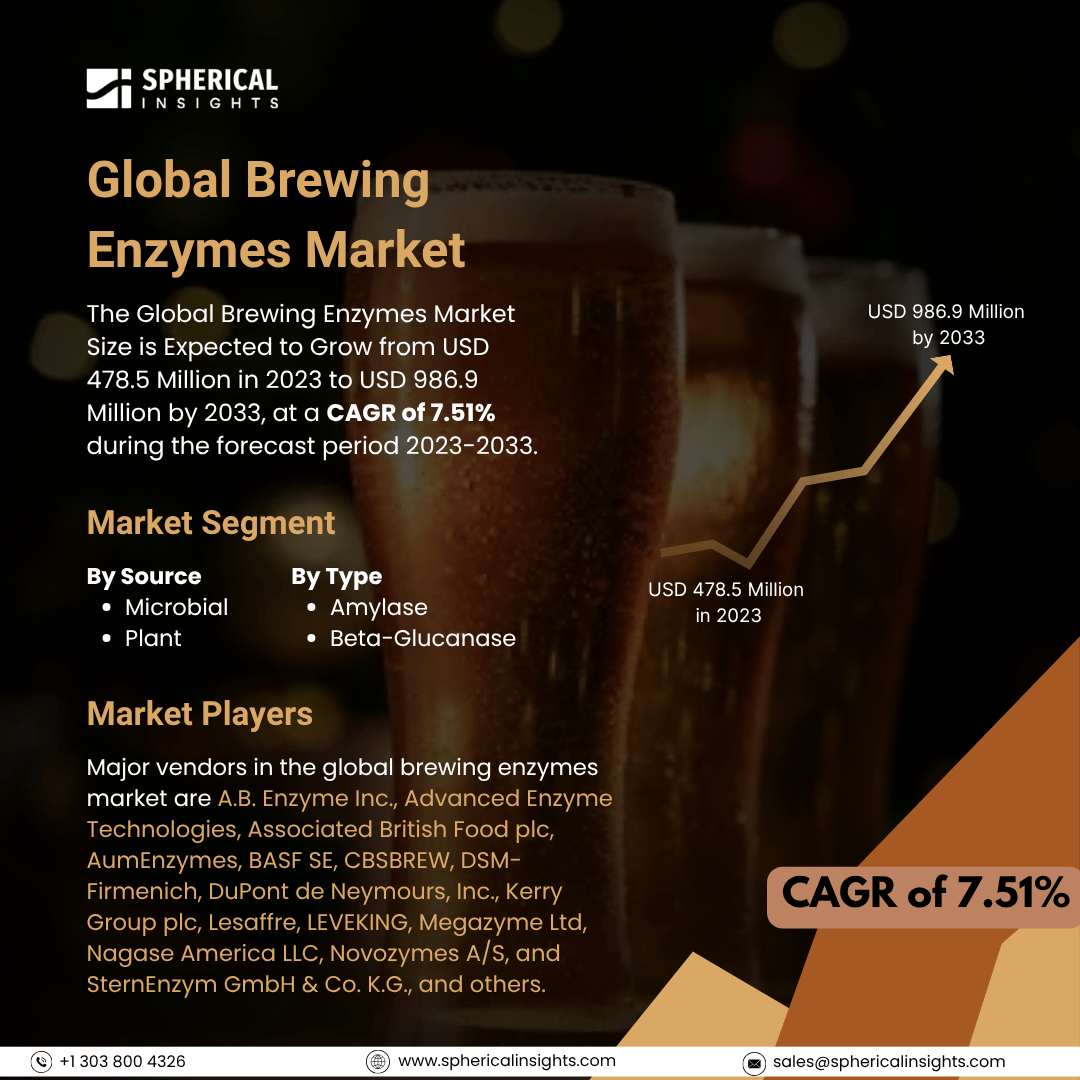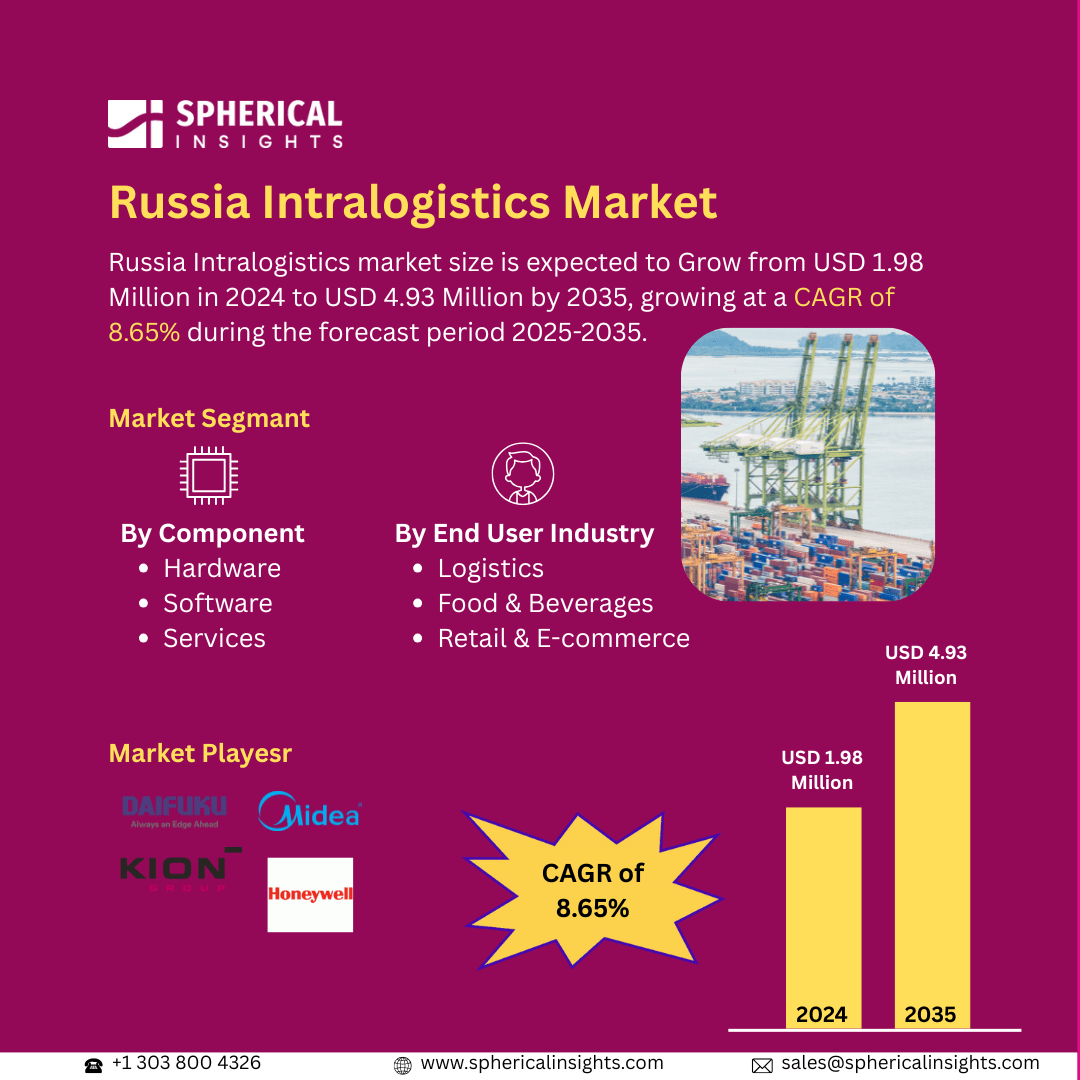Global Brewing Enzymes Market Size To Exceed USD 986.9 Million By 2033
According to a research report published by Spherical Insights & Consulting, The Global Brewing Enzymes Market Size is Expected to Grow from USD 478.5 Million in 2023 to USD 986.9 Million by 2033, at a CAGR of 7.51% during the forecast period 2023-2033.
Browse 210 Market Data Tables And 45 Figures Spread Through 190 Pages and In-Depth TOC On the Global Brewing Enzymes Market Size, Share, and COVID-19 Impact Analysis, By Source (Microbial and Plant), By Type (Amylase and Beta-Glucanase), and By Region (North America, Europe, Asia-Pacific, Latin America, Middle East, and Africa), Analysis and Forecast 2023 - 2033.
The demand and supply for enzymes used in the manufacturing of wine, beer, and other alcoholic drinks worldwide are included in the brewing enzymes market. These enzymes are necessary for the breakdown of complex substances, such as protein and starch, into simpler forms that yeast can ferment. Enzyme types (such as amylase, protease, and beta-glucanase), sources (microbial or plant-derived), and uses are used to segment the market. This is during the brewing process, certain biochemical reactions are accelerated by brewing enzymes, which are biological catalysts, usually proteins. These are essential for breaking down proteins, changing grain cell walls, and turning starches into sugars, all of which contribute to the creation of beer. These enzymes are necessary for producing beer in an effective and superior manner. Furthermore, the emergence of the cocktail craze and the expanding younger demographic reaching the legal drinking age, there is competition among different end consumers worldwide for market share. The consumption rate of wine and beer is greater per population category. However, one major factor limiting the market expansion for brewing enzymes is the low price of malt.
The microbial segment dominated the largest share in 2023 and is anticipated to grow at a significant CAGR during the forecast period.
Based on the source, the global brewing enzymes market is divided into microbial and plant. Among these, the microbial segment dominated the largest share in 2023 and is anticipated to grow at a significant CAGR during the forecast period. This is mostly due to the growing need for microbial products in a variety of sectors, such as biotechnology, healthcare, and agriculture, which emphasizes their revolutionary potential. Brewing enzymes derived from microorganisms are more manageable and produce large quantities of output.
The amylase segment held the highest share in 2023 and is anticipated to grow at a significant CAGR during the forecast period.
Based on the type, the global brewing enzymes market is divided into amylase and beta-glucanase. Among these, the amylase segment held the highest share in 2023 and is anticipated to grow at a significant CAGR during the forecast period. Compared to other brewing enzymes, amylases are less expensive and need less time to create. These are the most popular kind of enzyme that is now on the market since it has a good effect on the brewing process's production efficiency.
Asia Pacific is anticipated to hold the highest share of the global brewing enzymes market over the projected period.
Asia Pacific is anticipated to hold the highest share of the global brewing enzymes market over the projected period. The growing number of artisan breweries that serve a clientele that favors value over volume-based drinking is expected to sustain this rise throughout the course of the projected period. In addition, breweries use a variety of enzymes to balance the cost of raw materials.
North America is estimated to grow at the fastest CAGR of the global brewing enzymes market during the forecast period. This is due to increased rivalry in the beer industry and the desire to increase economic viability, the US market is expanding. The Brewers Association reports that 9,000 breweries were operating in the United States, a 6% increase, despite the pandemic.
Company Profiling
Major vendors in the global brewing enzymes market are A.B. Enzyme Inc., Advanced Enzyme Technologies, Associated British Food plc, AumEnzymes, BASF SE, CBSBREW, DSM-Firmenich, DuPont de Neymours, Inc., Kerry Group plc, Lesaffre, LEVEKING, Megazyme Ltd, Nagase America LLC, Novozymes A/S, and SternEnzym GmbH & Co. K.G., and others.
Key Target Audience
- Market Players
- Investors
- End-users
- Government Authorities
- Consulting and Research Firm
- Venture capitalists
- Value-Added Resellers (VARs)
Recent Development
- In September 2024, A revolutionary enzyme solution called DIAZYME® NOLO was introduced by IFF (NYSE: IFF) to improve the flavor, productivity, and manufacturing capacity of NOLO beverages without the need for expensive capital expenditures. The increasing demand for NOLO beverages will be satisfied by this innovation.
Market Segment
This study forecasts revenue at the global, regional, and country levels from 2023 to 2033. Spherical Insights has segmented the global brewing enzymes market based on the below-mentioned segments:
Global Brewing Enzymes Market, By Source
Global Brewing Enzymes Market, By Type
Global Brewing Enzymes Market, By Regional
- North America
- Europe
- Germany
- UK
- France
- Italy
- Spain
- Russia
- Rest of Europe
- Asia Pacific
- China
- Japan
- India
- South Korea
- Australia
- Rest of Asia Pacific
- South America
- Brazil
- Argentina
- Rest of South America
- Middle East & Africa
- UAE
- Saudi Arabia
- Qatar
- South Africa
- Rest of the Middle East & Africa



